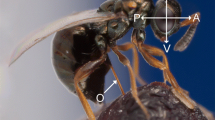Abstract
Octopamine receptors in the nervous tissue of insects were investigated using a ligand-receptor assay with [3H]NC-5Z or [3H]octopamine as the radioligands. Both ligands recognized a homogenous class of binding sites with the properties of an octopamine receptor. This receptor has been characterized pharmacologically. Both high-affinity agonists (e.g. NC 7, K1=0.3 nM) and antagonists (e.g. maroxepine, K1=1.02 nM) were investigated. The neuronal octopamine receptor belongs to a receptor class that can easily be distinguished from peripheral octopamine receptors. Initial investigations of the localization of octopamine receptors within the insect nervous tissue show the greatest receptor density in the optic lobes.
Similar content being viewed by others
References
Axelrod, J., and Saavedra, J. M. 1977. Octopamine, Nature 265:501–504.
Orchard, I. 1982, Octopamine in insects: neurotransmitter, neurohormone, and neuromodulator, Can. J. Zool. 60:659–669.
Saavedra, J. M. 1989. β-Phenylethylamine, Phenylethanolamine, tyramine and octopamine, Handbook Exp. Pharmacol. 90:181–210.
Nathanson, J. A. 1979. Octopamine receptors, adenosine 3′, 5′-monophosphate and neural control of firefly flashing, Science 203, 65–68.
Evans, P. D. 1981. Multiple receptor types for octopamine in the locust, J. Physiol. 318:99–102.
Ramirez, J.-M. 1990. Octopaminergic modulation of the forewing stretch receptor in the locustLocusta migratoria, J. exp. Biol. 149:255–279.
Hamdorf, K., Höglund, G., Juse, A., and Stusek, P. 1989. Effect of neurotransmitter on movement of screening pigment in insect superposition eyes. Z. Naturforsch. 44c:992–998.
Linn, C. E. and Roelofs, W. L. 1986. Modulatory effects of octopamine and serotonin on male sensitivity and periodicity of response to sex pheromone in the cabbage looper moth,Trichuplusia ni, Arch. Insect Biochem. Physiol. 3:161–171.
Sombati, S., and Hoyle, G. 1984. Generation of specific behaviours in a locust by local release into neuropil of the natural neuromodulator octopamine, J. Neurobiol. 6:481–506.
Bicker, G., and Menzel, R. 1989. Chemical codes for the control of behaviour in arthropods, Nature 337:33–39.
Nathanson, J. A. 1989. Development of a photoaffinity ligand for octopamine receptors, Molec. Pharmacol. 35:34–43.
Nathanson, J. A., and Kaugars, G. 1989. A probe for octopamine receptors: Synthesis of 2-(4-azido-2, 6-diethylphenylimino)-imidazolidine and its tritiated derivative. A potent reversible and irreversible activator of octopamine-sensitive adenylate cyclase, J. Med. Chem. 32:1795–1799.
Roeder, T., and Gewecke, M. 1990. Octopamine receptors in locust nervous tissue, Biochem. Pharmacol. 39:1793–1797.
Nathanson, J. A. 1985. Characterization of octopamine-sensitive adenylate cyclase: elucidation of a class of potent and selective octopamine receptor agonists with toxic effects in insects. Proc. Natl. Acad. Sci. USA 82:599–603.
Nathanson, J. A. 1985. Phenyliminoimidazolidines: Characterization of a class of potent agonists of octopamine-sensitive adenylate cyclase and their use in understanding the pharmacology of octopamine receptors, Molec. Pharmacol. 28:254–268.
Saudou, F., N. Amlaiky, N., Plassat, J. L., Borelli, E., and Hen, R. 1990. Cloning and characterization of aDrosophila tyramine receptor, EMBO J. 9:3611–3617.
Nathanson, J. A. 1992. Identification of potent octopaminergic agonists with selectivity for neuronal vs. nonneuronal octopamine receptors, manuscript submitted for publication.
Guillen, A., Haro, A., and Municio, A. M. 1989. A possible new class of octopamine receptors coupled to adenylate cyclase in the brain of the dipterousCeratitis capitata. Pharmacological characterization and regulation of [3H]octopamine binding, Life Sci. 45:655–662.
Wang, Z., R. G. H. Downer, J. W. D. Gole, and G. L. Orr, 1991. Characterization and pharmacological studies of an octopamine-sensitive adenylate cyclase from nerve cord ofLocusta migratoria, Arch. Int. Physiol. Biochim. Biophys. 99:189–193.
Kaufmann, L., and Benson, J. A. 1991. Characterization of a locust neuronal octopamine response, Soc. Neurosci. Abs. 17:277.
Evans, P. D. and Gee, J. D. 1980. Action of formamidine pesticides on octopamine receptors, Nature 287:60–62.
Author information
Authors and Affiliations
Rights and permissions
About this article
Cite this article
Roeder, T., Nathanson, J.A. Characterization of insect neuronal octopamine receptors (OA3 receptors). Neurochem Res 18, 921–925 (1993). https://doi.org/10.1007/BF00998278
Accepted:
Issue Date:
DOI: https://doi.org/10.1007/BF00998278




